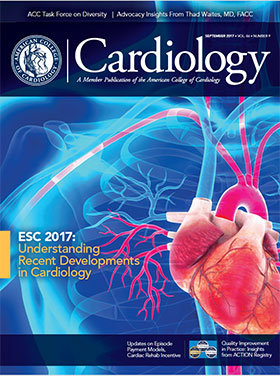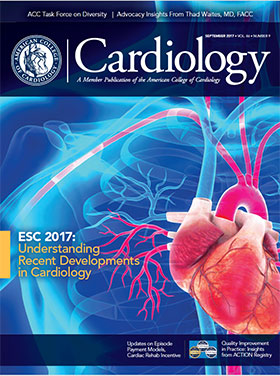Feature Story | More Clinical Insights From ESC 2017 Congress
Diabetes and its impact in cardiovascular disease continues to take center stage at cardiology conferences and more insights came from presentations at ESC Congress 2017. Here’s a look at some new findings in diabetes, heart failure, hypertension and prevention selected by our editors.
Diabetes and Heart Failure
Sodium glucose co-transporter-2 (SGLT-2) inhibitors given to patients with diabetes improved heart failure outcomes according to the EMPA-REG OUTCOME and CVD-REAL results presented at the ESC Congress.
Empagliflozin reduced heart failure (HF) hospitalization and cardiovascular mortality in patients with type 2 diabetes (T2D) without HF regardless of their HF risk, according to an analysis from the EMPA-REG OUTCOME trial. The results were presented by Javed Butler, MD, MPH, FACC, simultaneously published in the European Heart Journal.
The baseline five-year risk of HF was low-to-average (<10 percent) in 67.2 percent, high (10-20 percent) in 24.2 percent and very high (≥20 percent) in 5.1 percent of patients. The median Health ABC score was 4 (–8 to 16) in the placebo group and 4 (–8 to 18) in the pooled (10 mg and 25 mg) empagliflozin group. The patients with very high risk had a worse cardiometabolic profile, resembling the prevalent HF population, compared with the other risk groups.
The benefit of empagliflozin was consistent across the risk groups for the incidence of HF hospitalization or cardiovascular death and individual outcomes.
In the empagliflozin group vs. placebo group, the incidence of HF hospitalization or cardiovascular death per 100-patient years was 1.20 (95 percent CI, 0.98-1.45) vs. 1.68 (95 percent CI, 1.31-2.10) for the low-to-average HF risk group; 2.07 (95 percent CI, 1.58-2.62) vs. 4.03 (95 percent CI, 3.06-5.13) in the high-risk group; and 3.8 (95 percent CI, 2.38-5.54) vs. 7.0 (95 percent CI, 4.33-10.29) in the very high risk group. The hazard ratio (HR) for the three risk groups was, respectively, 0.71, 0.52 and 0.55.
This analysis revealed that a large percentage of patients with T2D and established cardiovascular disease have a high or very high risk for HF outcomes, according to the investigators. They concluded, “Empagliflozin reduced heart failure hospitalization and cardiovascular mortality in type 2 diabetes patients without HF at baseline across a spectrum of HF risk.”
"While the findings of this study [PURE] are provocative and add to our understanding of the relationship between diet and disease, deriving firm conclusions for all populations from these types of cohort studies should be taken with a grain of salt (pun intended)." — Jeffrey T. Kuvin, MD, FACC
Another analysis from EMPA-REG OUTCOME showed that empagliflozin added to standard of care was associated with substantial reductions in cardiovascular death and all-cause mortality as well as hospitalization for HF in patients with T2D who’d had a CABG. The magnitude of the benefits in the CABG subgroup was at least as large as that in the main trial, yielding important translational implications for secondary prevention following CABG, said presenter Subodh Verma, MD, PhD.
In 1,738 patients with a prior CABG (1,175 patients taking empagliflozin), the composite of cardiovascular death, non-fatal myocardial infarction (MI) and stroke (3-point MACE) was 10.6 percent in the pooled empagliflozin group vs. 13.3 percent in the placebo group. With empagliflozin vs. placebo, the incidence of all-cause mortality was 5.1 percent vs. 8.9 percent and of cardiovascular death was 3.0 percent vs. 5.7 percent. For stroke, the incidence was 3.3 percent vs. 2.7 percent with empagliflozin vs. placebo, and for MI it was 5.7 percent vs. 7.1 percent. The time to the first event for all events analyzed including time to hospitalization for heart failure and incident or worsening nephropathy was lower in patients with a history of CABG compared with those who did not.
The multinational, observational CVD-REAL study of more than 1.3 million patients with T2D previously reported that SGLT-2 inhibitors were associated with a lower risk of death and HF compared with other glucose-lowering drugs. In the present analysis, the investigators examined whether demographic, clinical and treatment effects modified the effect of the SGLT-2 inhibitors on HF, all-cause death and the composite of these.
A consistent benefit for a lower risk of HF events and all-cause death was found with the SGLT-2 inhibitors compared with other glucose-lowering drugs in relation to age (younger or older than 65 years), sex, and background therapies for cardiovascular diseases or diabetes. The mean follow-up was 225 days and there were 153,078 patients in each of the propensity matched groups.
Anna Norhammar, MD, stated in presenting the results that no modification of the effect of SGLT-2 inhibitors was observed for any of the key demographic factors, suggesting that the cardiovascular benefits associated with this class of drug may extend to a broad population of patients with T2D. The ongoing DECLARE-TIMI 58 will provide further evidence of the cardiovascular benefits of SGLT-2 inhibitors, including in lower risk patients.
Of course, no medication – no matter how traditional or novel – will work if they are not prescribed to the patients who’d benefit. More confirmation came from the CLARIFY registry that physician adherence to guideline recommendations for patients with HF and reduced ejection fraction was associated with better long-term outcomes. The large international registry had previously reported improved clinical outcomes at six months and this latest report showed better outcomes at 18 months.
The findings emphasize the importance of optimizing disease-modifying HF medications to improve long-term mortality and HF hospitalization, said presenter Michel Komajda, MD.
Hypertension
Is renal denervation back in play? Primary results from the SPYRAL HTN-OFF MED trial provide biological proof of principle for the efficacy of catheter-based renal denervation to reduce blood pressure in patients with hypertension not treated with antihypertensive medications, according to the investigators. The findings were presented by Michel Bohm, MD, and simultaneously published in The Lancet.
The multicenter, international trial randomly assigned 80 patients from the U.S., Europe, Japan and Australia who were either drug-naïve or had discontinued their antihypertensive medications to either renal denervation (n = 38) or sham control (n = 42). Patients were followed for up to three months and the primary endpoint was change in 24-hour blood pressure at the end of the follow-up period. Drug surveillance was performed to ensure patient compliance with absence of antihypertensive medication.
Results showed a significant decrease from baseline to three months in office and 24-hour ambulatory blood pressure in the renal denervation group, while no significant changes were noted in the sham-control group. Researchers highlighted that the mean difference between the groups favored renal denervation for three-month change in both office and 24-hour blood pressure. There were no major adverse events reported in either group.
“This novel trial differs substantially from previous renal denervation trials in terms of the hypertensive population enrolled, the renal denervation technique used, and the absence of concomitant antihypertensive medications,” researchers wrote. “To our knowledge, this is the first rigorously done sham controlled clinical trial to assess blood pressure reduction in hypertensive patients in the absence of antihypertensive medications.”
Looking ahead, results from SPYRAL HTN-OFF Med are expected to inform the design of a larger, pivotal trial addressing the role of renal denervation in treatment of hypertension. ACC.org Editor-in-Chief Kim A. Eagle, MD, MACC, comments that due to the small numbers of patients enrolled in this trial, it remains unclear if this invasive strategy will find a clinical niche in the treatment of hypertension.
A perennial question in hypertension is the J-curve. In patients with hypertension and coronary artery disease, observational studies have demonstrated a J-shaped relationship between diastolic blood pressure (BP) and cardiovascular events. The CLARIFY registry presented at ESC Congress 2017 has now shown an independent association between elevated pulse pressure and increased cardiovascular risk. However, the investigators stated the elevated pulse pressure is not the major determinant of the increased risk associated with low diastolic blood pressure in the 22,672 patients with coronary artery disease followed for a median of five years in this registry.
For the primary outcome of cardiovascular death or myocardial infarction, elevated pulse pressure was associated with an increased risk (adjusted HR, 1.54 for pulse pressures of 65-74 mm Hg and 2.33 for pulse pressures ≥75 mm Hg, compared with a pulse pressure of 45-54 mmHg). A low pulse pressure (<45 mm Hg) was also associated with an increased risk (HR,1.62).
The relationship between diastolic BP and cardiovascular events was J-shaped, with HRs of 1.43 and 2.10 for diastolic blood pressure of 60-69 mm Hg and <60 mm Hg respectively, and HRs of 1.39 and 3.55 for diastolic blood pressure of 80-89 mm Hg and ≥90 mm Hg respectively, compared with a diastolic BP of 70-79 mm Hg.
As the investigators noted, while the observational studies generate hypotheses, randomized clinical trials will be needed to provide definite proof of potential harmfulness of excessive pharmacological lowering of diastolic blood pressure.
Diet and Cardiovascular Disease
Separate findings from the PURE study suggesting an association between cardiovascular disease and mortality and fruit, vegetables and legume intake, as well as intake of fats and carbohydrates, could have an impact on global dietary guidelines, according to researchers presenting at ESC Congress 2017 in Barcelona.
All three studies, which were published in The Lancet, are based on the large, epidemiological PURE study involving 135,335 individuals aged 35-70 years across 18 countries and five continents between January 2003 and March 2013. Researchers used country-specific food frequency questionnaires at baseline and collected demographic, socioeconomic, lifestyle, family history and individual health history and medication information. The primary clinical outcomes were major cardiovascular disease, fatal and non-fatal MI, fatal and non-fatal stroke, cardiovascular mortality, non-cardiovascular mortality and total mortality. During a median 7.4 years (5.5-9.3), there were 4,784 major cardiovascular disease events, 1,649 cardiovascular deaths and 5,796 total deaths.
In an analysis of fruit, vegetable and legume intake, researchers found a higher consumption was associated with a lower risk of non-cardiovascular and total mortality. Three to four servings per day (equivalent to 375-500 g/day) appeared to provide the maximum benefits for both non-cardiovascular mortality and total mortality. When looked at separately, researchers noted fruit intake was associated with lower risk of cardiovascular, non-cardiovascular and total mortality, while legume intake was inversely associated with non-cardiovascular death and total mortality. Raw vegetable intake was strongly associated with a lower risk of total mortality, while cooked vegetables were associated with a modest benefit against mortality.
A separate analysis of nutrient intake (carbohydrate, fats and protein) found high carbohydrate intake was associated with higher risk of total mortality, but not with the risk of cardiovascular disease or cardiovascular disease mortality. Total fat and individual types of fat were associated with lower risk of total mortality, but were not significantly associated with risk of myocardial infarction or cardiovascular disease mortality. Higher saturated fat intake was associated with lower risk of stroke.
In a third analysis, not presented at ESC, multilevel modeling was used to assess the effect of dietary nutrients on blood lipids and blood pressure in 125,287 PURE participants. Intake of total fat and each type of fat was associated with higher concentrations of total cholesterol and LDL cholesterol (LDL-C), and with higher HDL cholesterol (HDL-C) and apolipoprotein A1 (ApoA1), and lower triglycerides, ratio of total cholesterol to HDL-C, ratio of triglycerides to HDL-C, and ratio of apolipoprotein B (ApoB) to ApoA1. Higher carbohydrate intake was associated with lower total cholesterol, LDL-C and ApoB, but also with lower HDL-C and ApoA1, and higher triglycerides, ratio of total cholesterol to HDL-C, ratio of triglycerides to HDL-C, and ApoB-to-ApoA1.
Higher intakes of total fat, saturated fatty acids and carbohydrates were also associated with higher blood pressure, whereas higher protein intake was associated with lower blood pressure. Replacement of saturated fatty acids with carbohydrates was associated with the most adverse effects on lipids, according to researchers. While replacement of saturated fatty acids with unsaturated fats improved some risk markers (LDL-C and blood pressure), it seemed to worsen others (HDL-C and triglycerides).
“The PURE study was an incredibly large, international effort with robust follow-up over seven years focusing on the relationship between dietary habits and cardiovascular outcomes. The authors conclude that a diet rich in carbohydrates, not fat, was associated with elevated risk of total mortality,” says Jeffrey T. Kuvin, MD, FACC.
“This furthers our suspicion that a diet heavy in carbohydrates can have long-term negative effects on cardiovascular health. While the findings of this study are provocative and add to our understanding of the relationship between diet and disease, deriving firm conclusions for all populations from these types of cohort studies should be taken with a grain of salt (pun intended),” Kuvin adds. “Importantly, we need to continue to examine the impact of a diet in controlled settings to tease out the specific role that certain foods have on health. While these outcomes studies are difficult to perform, the PURE study certainly helps to further our understanding. Until we get more definitive data, my take away from this study, and other similar studies, is everything in moderation, including diet.”
Tweet this article: Tweet

 |
|
| Click the cover image above to read the latest issue of Cardiology in e-pub format or click here to read it on the web! | |
Keywords: ACC Publications, Cardiology Magazine, Antihypertensive Agents, Apolipoprotein A-I, Apolipoproteins B, Benzhydryl Compounds, Blood Pressure, Blood Pressure Monitoring, Ambulatory, Carbohydrates, Cardiovascular Diseases, Cholesterol, HDL, Cholesterol, LDL, Cause of Death, Cohort Studies, Control Groups, Coronary Artery Disease, Demography, Denervation, Diabetes Mellitus, Type 2, Energy Intake, Epidemiologic Studies, Fabaceae, Fats, Unsaturated, Fatty Acids, Follow-Up Studies, Glucose, Glucosides, Heart Failure, Hospitalization, Hypertension, Life Style, Lipids, Myocardial Infarction, Nutrition Policy, omega-Chloroacetophenone, Patient Compliance, Registries, Research Personnel, Risk Factors, Secondary Prevention, Sodium, Sodium Chloride, Dietary, Standard of Care, Stroke, Stroke Volume, Symporters, Triglycerides
< Back to Listings

